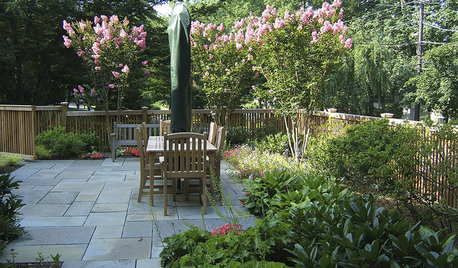crepe myrtle bark question
helenh
15 years ago
Related Stories

GARDENING GUIDESGreat Design Plant: Crape Myrtle
With long-lasting blooms and gorgeous exfoliating bark, this ornamental tree brings bright color and a unique form to the landscape
Full Story
GARDENING GUIDES5 Best-Behaved Trees to Grace a Patio
Big enough for shade but small enough for easy care, these amiable trees mind their manners in a modest outdoor space
Full Story
GROUND COVERSGround Force: 10 Top Ground Covers for Your Garden
Protect your soil from weeds and drought this summer with a living mulch of ground covers
Full Story
LANDSCAPE DESIGNPretty Trees for Patios, Paths and Other Tight Spots
Choose trees for their size, shape and rate of growth — or shape them to fit your space. Here's how to get started
Full Story
SIDE YARD IDEASNarrow Trees for Tight Garden Spaces
Boost interest in a side yard or another space-challenged area with the fragrance and color of these columnar trees
Full Story
GARDENING GUIDESHow to Pick a Mulch — and Why Your Soil Wants It
There's more to topdressing than shredded wood. Learn about mulch types, costs and design considerations here
Full Story
GARDENING GUIDESLet Lilac Love Flower This Spring
Whatever you bestow or receive for Mother's Day, lilacs can be an unmatched gift in the garden in May
Full Story
SAVING WATERHouzz Call: Are You Letting Go of Your Lawn?
Many facing a drought are swapping turf for less thirsty plantings. If you’re one of them, we’d like to hear about it
Full Story
LANDSCAPE DESIGN7 Great Trees for Summer Shade and Fall Color
These landscape-pro faves straddle the seasons beautifully. Could one enhance your own yard?
Full Story
EXTERIORSWhere Front Yards Collide: Property Lines in Pictures
Some could be twins; others channel the Odd Couple. You may never look at property boundaries the same way again
Full StoryMore Discussions






pauln
helenhOriginal Author
Related Professionals
Danbury Landscape Architects & Landscape Designers · Manhattan Beach Landscape Architects & Landscape Designers · Parole Landscape Architects & Landscape Designers · Severn Landscape Architects & Landscape Designers · Waunakee Landscape Architects & Landscape Designers · Salem Landscape Contractors · Hoffman Estates Landscape Contractors · Paramus Landscape Contractors · Parker Landscape Contractors · Riverview Landscape Contractors · Sugar Hill Landscape Contractors · Wanaque Landscape Contractors · Selma Landscape Contractors · Norridge Landscape Contractors · Camp Springs Landscape Contractorsgldno1
helenhOriginal Author
christie_sw_mo
christie_sw_mo
helenhOriginal Author
helenhOriginal Author
pauln
helenhOriginal Author